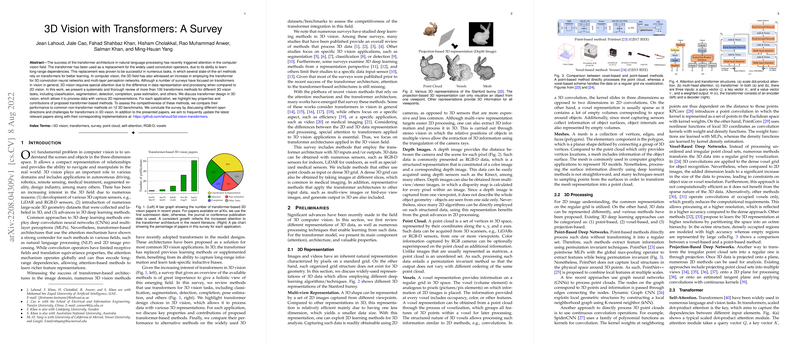3D Vision with Transformers: An Analytical Overview
The paper "3D Vision with Transformers: A Survey" offers a comprehensive examination of the burgeoning application of transformer architectures in 3D computer vision tasks. The authors meticulously review a vast array of over 100 transformer-based methods, highlighting significant advances across several domains, including classification, segmentation, detection, completion, pose estimation, and other applications. The survey provides an adept analysis of the distinct challenges and considerations involved in transferring the typically 2D-focused transformer model to the 3D domain, which often involves different data representations such as point clouds, voxels, and RGB-D data.
Summary of Contributions and Approach
The paper posits that transformers, initially designed for NLP tasks, have proven successful in replacing convolutions due to their ability to capture long-range dependencies in input data. With the increasing interest in extending these capabilities to 3D vision, the survey conducts a detailed comparison of transformer design choices across diverse 3D applications.
Key contributions include:
- Comprehensive Exploration: An exhaustive compendium of methods applied across various 3D tasks, classified into subcategories based on their input representation, scalability, and context (local vs. global processing).
- Analysis of Design Choices: Consideration of crucial factors influencing the adoption of transformers, such as data sampling strategies, context level analysis, and the balance between transformer and hybrid architectures.
- Benchmark Comparisons: Performance benchmarking of leading transformer-based methods against established non-transformer models, highlighting both successes and areas requiring further refinement.
Numerical Results and Claims
The numerical evaluations elucidate the promise of transformer approaches in improving task-specific performance metrics. For instance, in 3D object classification, methods like Point-BERT and Point-MAE, benefiting from pre-training, show strong performance on benchmarks such as ModelNet40 and ScanObjectNN.
The survey also discusses tasks like 3D segmentation and object detection. Notably, the Stratified Transformer achieves state-of-the-art results in 3D scene segmentation, suggesting that efficient implementation of transformers tailored to 3D data can enhance both local and global feature learning. In 3D object detection, methods like BrT demonstrate the capability of transformers to effectively integrate multimodal data from point clouds and images, achieving superior results on datasets such as SUN RGB-D and ScanNet.
Implications and Future Directions
This survey highlights several implications for the continued development of transformer architectures in 3D vision:
- Scalability and Efficiency: Addressing the computational complexity associated with transformer architectures remains paramount. Efficient sampling methods and scalable architectures that balance resolution and coverage require further exploration.
- Position Embeddings: Proper encoding of positional information in three-dimensional space is crucial for capturing the geometric nuances of 3D data, underscoring a need to refine or innovate position embedding strategies specific to 3D applications.
- Data Augmentation and Pre-training: Employing robust data augmentation strategies and establishing large-scale pre-training protocols could significantly boost the performance and generalization capabilities of 3D transformers, paralleling advances made in 2D domains.
Conclusion
The surveyed paper provides significant insights into the current landscape of transformer applications in 3D vision. By assessing diverse methodologies and drawing comparisons across various datasets, it identifies the strengths and potential areas for growth in utilizing transformers for 3D tasks. This analysis serves as a valuable resource for ongoing research and development in adaptive transformer architectures tailored to the complexities and opportunities inherent in 3D data processing.
